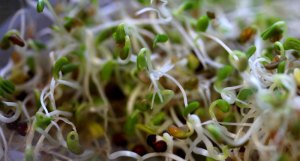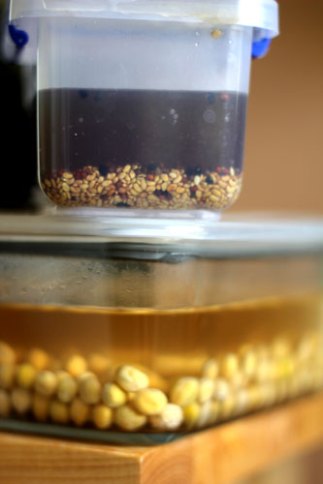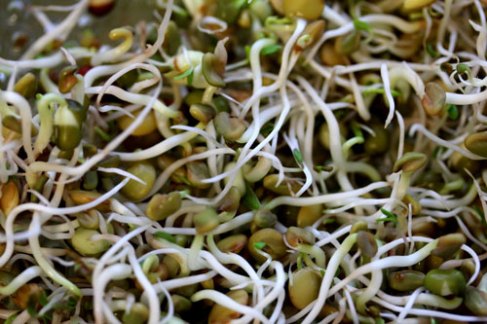I’ve had several sprout-growing eras. I embrace sprouting for a while and then it tends to become cumbersome, I tend to become negligent, sprouts tend to moulder into a stinky mess…and I wander dejectedly away from sprouting for a couple of years. Right now I’m in another sprouting golden age. They’re growing well, I crave them all the time, I feel healthier for eating them and all is good. In fact, I’m snacking on a small mountain of them right now.
 Here’s what I know now about sprouts that has made it all so much better:
Here’s what I know now about sprouts that has made it all so much better:
1. Hemp sprout bags are the perfect growing environment.
I’ve invested in several sprouting gizmos. You can even spend several hundred dollars on an automated sprout factory that does it all for you. The thing is, “it all” is about 6 minutes of effort a day, rinsing. That’s it. Simple! All the sprouters I’ve bought have been somehow ineffective. The drainage holes block with small seeds, the water collection tray is too small, the height doesn’t allow sprouts to grow sufficiently…I could go on. Enter the hemp sprouting bag! These are hands down the simplest growing method. You put few tablespoons of seed inside, soak the bag/s in a bowl of water overnight (see number 2 for a tip about this), rinse twice a day and hang them on a hook over the sink in the meantime. When the sprouts are ready to eat, I turn them out onto a colander (or one of my abandoned sprouting tray sets) and leave them on the kitchen bench to do a little photosynthesising and become deliciously green. In between batches, give the bags a good handwash and soak in low concentration hydrogen peroxide to keep mould at bay. Easy!
2. Soaking water can be enriched with a drop of natrakelp and a dozen squirts of magnesium oil.
From what I’ve read and observed, this seems like a good way I boost the health benefits and rigour of my sprouts. They grow quicker, and are better for me too. I’ve just bought some potassium humate which I’ll start adding into the mix too.
3. Make sprouting part of a cycle within your system.
Confession time. I am a terrible slacker when it comes to watering the gardening. Life is so busy and too often my balcony garden is out of sight, out of mind. So, plants get frail, feel neglected, even – I admit – shrivel up and die. I also get the guilts about wasting water with sprout rinsing. Voila…a cycle! Sprouts are in my kitchen so I see them all the time. They get rinsed over a bucket, which I take out to my balcony garden to water the plants. Watering becomes normal, and easy, no water gets wasted…and my plants get the benefits of all the goodness of sprout rinsing water.
4. Not all sprouts are equal.
Some types of sprouts are amazing. Others are drab. You’ll like some and be indifferent about others. Some will flourish, others will (at best) limp along. Snow peas are a good example. I soaked a pile of snowpea seeds, popped half in a sprouter and grew the other half as microgreens (in soil, that is). The sprouted ones took longer, and were an impoverished version of those that got the microgreen treatment. With a little experimenting, I’m getting to know what works and what I like best. I bought little quantities of seed first, then bought in bulk once I knew what grew best and got eaten most.


Anonymous
E A M Harris
thingsmybellylikes
Pingback: IMG_4514 | Living Simply By Going Backwards
jeninorton
Tilly
jeninorton